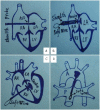Off-pump occlusion of trans-thoracic minimal invasive surgery (OPOTTMIS) on simple congenital heart diseases (ASD, VSD and PDA) attached consecutive 210 cases report: a single institute experience
- PMID: 21486486
- PMCID: PMC3090330
- DOI: 10.1186/1749-8090-6-48
Off-pump occlusion of trans-thoracic minimal invasive surgery (OPOTTMIS) on simple congenital heart diseases (ASD, VSD and PDA) attached consecutive 210 cases report: a single institute experience
Abstract
Objective: This paper intends to report our experiences by using an operation of off-pump occlusion of trans-thoracic minimal invasive surgery (OPOTTMIS) on the treatment of consecutive 210 patients with simple congenital heart diseases (CHD) including atrial septal defect (ASD), ventricular septal defect (VSD) and patent ductus arteriosus (PDA).
Methods: The retrospective clinical data of OPOTTMIS in our institute were collected and compared to other therapeutic measures adopted in the relevant literatures. After operation, all the patients received electrocardiography (ECG) and echocardiography (echo) once a month within the initial 3 months, and no less than once every 3 ~ 6 months later.
Results: The successful rate of the performed OPOTTMIS operation was 99.5%, the mortality and complication incidence within 72 hours were 0.5% and 4.8%, respectively. There were no major complications during peri-operation such as cardiac rupture, infective endocarditis, strokes, haemolysis and thrombosis. The post-operation follow-up outcomes by ECG and echo checks of 3 months to 5 years showed that there were no III° AVB, no obvious Occluder migration and device broken and no moderate cardiac valve regurgitation, except 1 VSD and 1 PDA with mild residual shunts, and 2 PDA with heart expansion after operation. However, all the patients' heart functions were in class I~II according to NYH standard.
Conclusion: The OPOTTMIS is a safe, less complex, feasible and effective choice to selected simple CHD patients with some good advantages and favorable short-term efficacies.
Figures





Similar articles
-
Application value of echocardiography in transthoracic punctural closure of postoperative residual ventricular septal defect of congenital heart disease.Zhong Nan Da Xue Xue Bao Yi Xue Ban. 2021 Dec 28;46(12):1380-1385. doi: 10.11817/j.issn.1672-7347.2021.200660. Zhong Nan Da Xue Xue Bao Yi Xue Ban. 2021. PMID: 35232908 Free PMC article. Chinese, English.
-
[Analysis and follow-up study on 8 children with combined congenital heart disease treated with simultaneous trans-catheter therapy].Zhongguo Dang Dai Er Ke Za Zhi. 2008 Oct;10(5):599-602. Zhongguo Dang Dai Er Ke Za Zhi. 2008. PMID: 18947479 Chinese.
-
Variation in practice patterns in device closure of atrial septal defects and patent ductus arteriosus: An analysis of data from the IMproving Pediatric and Adult Congenital Treatment (IMPACT) registry.Am Heart J. 2018 Feb;196:119-130. doi: 10.1016/j.ahj.2017.10.018. Epub 2017 Nov 2. Am Heart J. 2018. PMID: 29421004 Free PMC article.
-
Shunt Lesions Part I: Patent Ductus Arteriosus, Atrial Septal Defect, Ventricular Septal Defect, and Atrioventricular Septal Defect.Pediatr Crit Care Med. 2016 Aug;17(8 Suppl 1):S302-9. doi: 10.1097/PCC.0000000000000786. Pediatr Crit Care Med. 2016. PMID: 27490614 Review.
-
Evaluation of Left to Right Shunts by the Pediatrician: How to Follow, When to Refer for Intervention?Indian J Pediatr. 2015 Nov;82(11):1027-32. doi: 10.1007/s12098-015-1861-9. Epub 2015 Oct 10. Indian J Pediatr. 2015. PMID: 26452492 Review.
Cited by
-
Anterolateral minithoracotomy versus median sternotomy for the treatment of congenital heart defects: a meta-analysis and systematic review.J Cardiothorac Surg. 2012 May 4;7:43. doi: 10.1186/1749-8090-7-43. J Cardiothorac Surg. 2012. PMID: 22559820 Free PMC article.
-
Patent foramen ovale closure by using transesophageal echocardiography for cryptogenic stroke: single center experience in 132 consecutive patients.J Cardiothorac Surg. 2020 Jan 9;15(1):11. doi: 10.1186/s13019-020-1042-4. J Cardiothorac Surg. 2020. PMID: 31918738 Free PMC article.
-
A Narrative Review of Postoperative Anticoagulation Therapy for Congenital Cardiac Disease.Front Surg. 2022 Jun 14;9:907782. doi: 10.3389/fsurg.2022.907782. eCollection 2022. Front Surg. 2022. PMID: 35774388 Free PMC article. Review.
-
Peratrial Device Closure of Atrial Septal Defect Under Transesophageal Echocardiographic Guidance without Fluoroscopy Compared to Conventional On-Pump Surgical Closure.Braz J Cardiovasc Surg. 2017 Jan-Feb;32(1):38-42. doi: 10.21470/1678-9741-2016-0021. Braz J Cardiovasc Surg. 2017. PMID: 28423128 Free PMC article.
References
-
- Zhao JF, Yao W, Qi GQ. Advances in congenjtal heart disease catheter closure [J] Adv Cardiovasc dis. 2009;30(2):233–236.
-
- Sarris GE, Kirvassilis G, Zavaropoulos P. et al.Surgery for complications of trans-catheter closure of atrial septal defects: a multi-institutional study from the European Congenital Heart Surgeons Association [J] Eur J Cardiothorac Surg. 2010;37(6):1285–1290. doi: 10.1016/j.ejcts.2009.12.021. - DOI - PubMed
Publication types
MeSH terms
LinkOut - more resources
Full Text Sources
Medical

